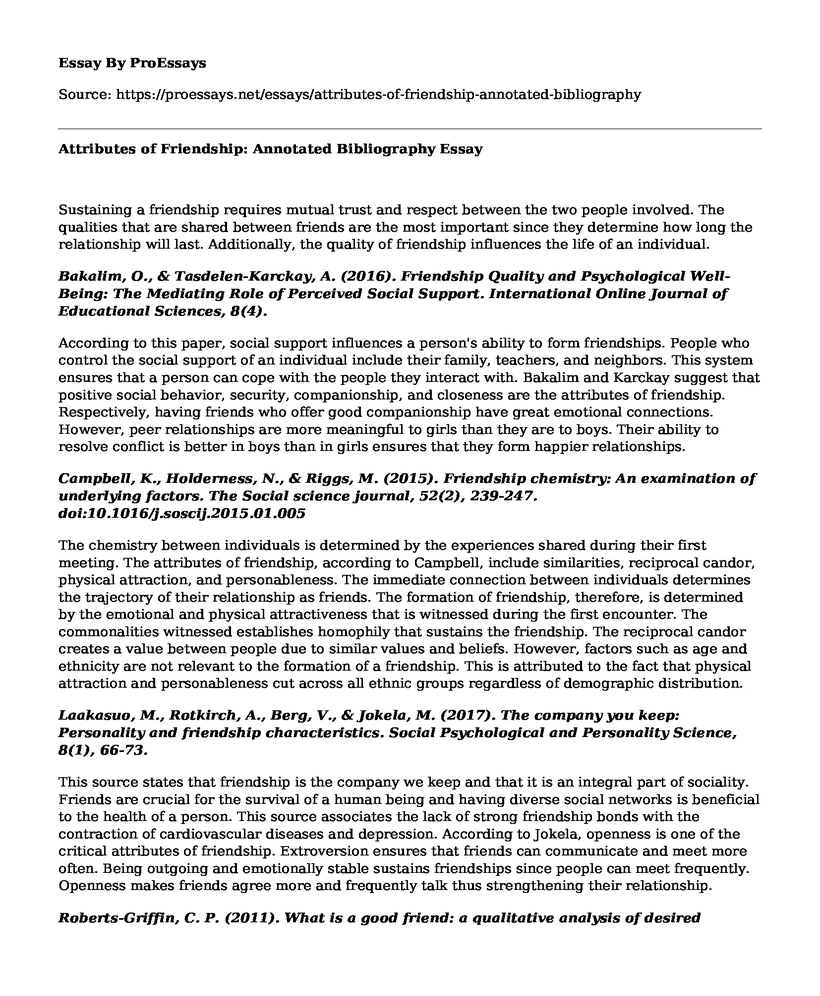Sustaining a friendship requires mutual trust and respect between the two people involved. The qualities that are shared between friends are the most important since they determine how long the relationship will last. Additionally, the quality of friendship influences the life of an individual.
Bakalim, O., & Tasdelen-Karckay, A. (2016). Friendship Quality and Psychological Well-Being: The Mediating Role of Perceived Social Support. International Online Journal of Educational Sciences, 8(4).
According to this paper, social support influences a person's ability to form friendships. People who control the social support of an individual include their family, teachers, and neighbors. This system ensures that a person can cope with the people they interact with. Bakalim and Karckay suggest that positive social behavior, security, companionship, and closeness are the attributes of friendship. Respectively, having friends who offer good companionship have great emotional connections. However, peer relationships are more meaningful to girls than they are to boys. Their ability to resolve conflict is better in boys than in girls ensures that they form happier relationships.
Campbell, K., Holderness, N., & Riggs, M. (2015). Friendship chemistry: An examination of underlying factors. The Social science journal, 52(2), 239-247. doi:10.1016/j.soscij.2015.01.005
The chemistry between individuals is determined by the experiences shared during their first meeting. The attributes of friendship, according to Campbell, include similarities, reciprocal candor, physical attraction, and personableness. The immediate connection between individuals determines the trajectory of their relationship as friends. The formation of friendship, therefore, is determined by the emotional and physical attractiveness that is witnessed during the first encounter. The commonalities witnessed establishes homophily that sustains the friendship. The reciprocal candor creates a value between people due to similar values and beliefs. However, factors such as age and ethnicity are not relevant to the formation of a friendship. This is attributed to the fact that physical attraction and personableness cut across all ethnic groups regardless of demographic distribution.
Laakasuo, M., Rotkirch, A., Berg, V., & Jokela, M. (2017). The company you keep: Personality and friendship characteristics. Social Psychological and Personality Science, 8(1), 66-73.
This source states that friendship is the company we keep and that it is an integral part of sociality. Friends are crucial for the survival of a human being and having diverse social networks is beneficial to the health of a person. This source associates the lack of strong friendship bonds with the contraction of cardiovascular diseases and depression. According to Jokela, openness is one of the critical attributes of friendship. Extroversion ensures that friends can communicate and meet more often. Being outgoing and emotionally stable sustains friendships since people can meet frequently. Openness makes friends agree more and frequently talk thus strengthening their relationship.
Roberts-Griffin, C. P. (2011). What is a good friend: a qualitative analysis of desired friendship qualities. Penn McNair Research Journal, 3(1), 5.
Griffin suggests that interpersonal attraction often leads to relationships. The relationships may be friendly or romantic. According to this source, similarity and attractiveness determine the direction of friendship. This study conducted a test to analyze how similarity and attractiveness influence happiness. For attractiveness to prosper, the author notes that there must be honesty, supportiveness, and trust. This source postulates that friendship is necessary to make sure that people are productive and that the well-being of every person is taken into consideration. Associations are psychologically adaptive, and they foster mental wellness especially among people with common interests.
Sigstad, H. M. H. (2017). Qualities in friendship-Within an outside perspective-Definitions expressed by adolescents with mild intellectual disabilities. Journal of intellectual disabilities, 21(1), 20-39.
This article presents the qualities of friendship in childhood and adolescence. According to the source, friendship bonds dictate how a young adult manages stress. Some of the qualities noted by Sigstad include mutual preference, bonding, and mutual enjoyment. These are the attributes of friendship that allow companionship among children to prosper beyond their childhood. Reciprocating preferences, emotions, and happiness promote social competence and it ensures that people keep each other as best friends. However, this paper asserts that children with disabilities prefer having friends who have similar disorders. Their friendships may not be mutual due to the inability to establish an intellectual or emotional bond on either side. Children with no learning disabilities form stronger friendships have more closeness.
Conclusion
On the whole, most of the sources record openness, trust, physical attraction, companionship, and strong emotional bonds as the most significant attributes of friendship. The personality traits of people define the strength and durability of an association. Therefore, relationships must be characterized by the ability of people to manifest good characteristics to ensure that they help other people maintain their emotional wellbeing.
Cite this page
Attributes of Friendship: Annotated Bibliography. (2022, Dec 11). Retrieved from https://proessays.net/essays/attributes-of-friendship-annotated-bibliography
If you are the original author of this essay and no longer wish to have it published on the ProEssays website, please click below to request its removal:
- Paper Example on Learning About Self: Language, Relationships & Schools
- Essay on Michael Kuo: Resisting Myths, Confronting Challenges, Finding a Savior
- Paper Example on Establishing Identity: Interaction, Material Worlds, & Social Behaviors
- Parental Involvement: Essential for Academic Success - Research Paper
- Japan's Population Decline: A Worrying Trend in a Growing World - Essay Sample
- Essay on Communicative Competence: Hymes' (1972) Revolutionary Concept in English Language Teaching
- Community Regulating: A New Way to Improve Safety & Quality of Life - Report Example







